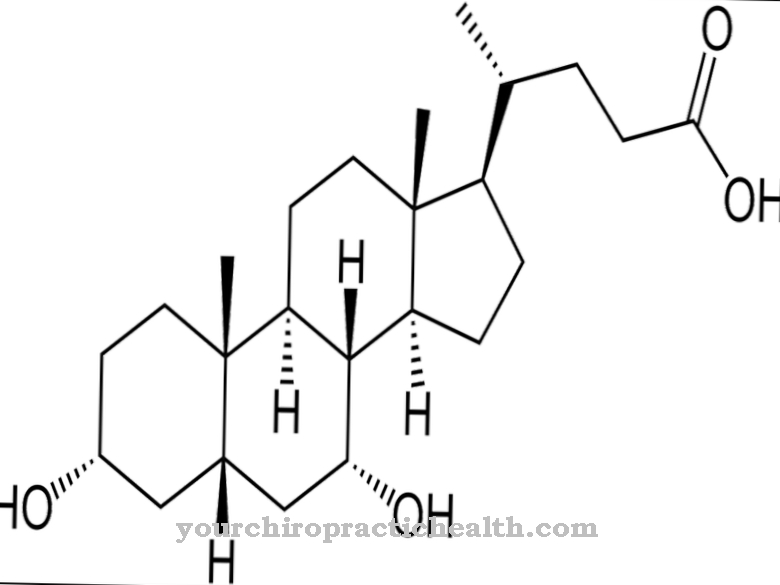At Olanzapine it is an atypical neuroleptic. The active ingredient is used to treat schizophrenic psychoses.
What is olanzapine?
The drug olanzapine is assigned to the atypical neuroleptics. It is one of the most important drugs for treating schizophrenia.In contrast to the older neuroleptics, olanzapine is better tolerated.
The active ingredient is considered relatively young. It originated from classic neuroleptics and was developed in the 1990s to treat psychological complaints. In Germany, olanzapine came onto the market in 1996 under the trade name Zyprexa®. The active ingredient belongs to the second generation of neuroleptics and has fewer side effects. However, a large increase in weight is possible. Since 2012 there are also some generics of olanzapine.
Pharmacological effect on the body and organs
The fact that people feel balanced and can react accordingly to certain situations such as fear, joy or excitement is made possible by the interaction of several messenger substances that work within the brain and spinal cord (which form the central nervous system (CNS)). This leads to the release of neurotransmitters such as dopamine and serotonin. These messenger substances are absorbed and stored later. In the case of schizophrenia, there is a disturbance in the balance of neurotransmitters.
The effect of olanzapine is based on the blockade of receptors (binding sites) of the neurotransmitter dopamine. In this way, typical symptoms of schizophrenia such as delusions or hallucinations can be alleviated. Furthermore, the neuroleptic occupies the binding sites of the neurotransmitter serotonin, which in turn has a positive effect on the apathy of the patient. This improves concentration and memory performance, while depression decreases. In addition, olanzapine ensures a slight calming of the patient and counteracts manias, in which the drive temporarily increases significantly.
As a dopamine antagonist, olanzapine inhibits the effect of dopamine. In the body of the loop (striatum), however, this only happens to 40 to 60 percent. For this reason, fewer extrapyramidal motor disorders (EPS) are caused than with older neuroleptics. As for side effects, olanzapine is a weaker variant of clozapine.
After ingestion by mouth, the drug can easily enter the bloodstream within the intestines. Once the olanzapine has distributed itself in the body, it is broken down within the liver. Most of the active ingredient is eliminated through the kidneys.
Medical application & use for treatment & prevention
The most important area of application for olanzapine is the therapy of psychoses that manifest themselves in schizophrenia or manic illness. The drug is particularly suitable for patients who no longer have any relation to reality and who therefore have strong states of excitement, severe depression and anxiety disorders. Olanzapine can also be used to treat hallucinations, delusions, personality disorders and aggressive behavior.
Other areas of application are bipolar disorders and suicidality. The drug is usually taken orally through tablets. In acute cases, however, there is also the possibility of an injection into the blood. The recommended daily dose is 10 milligrams. If necessary, it can be increased step by step to 20 milligrams per day.
The patient usually takes the olanzapine once a day, regardless of meals. Towards the end of therapy, the drug should be discontinued slowly so that symptoms such as anxiety, insomnia, tremors, nausea, vomiting and sweating do not occur. However, olanzapine can only develop its full positive effect after a few days or even weeks.
You can find your medication here
➔ Medicines to calm down and strengthen nervesRisks & side effects
Around 10 percent of all people treated with olanzapine experience undesirable side effects. These include primarily the increase in weight and drowsiness. About 1 to 10 percent of patients experience dizziness, dry mouth, low blood pressure, and constipation.
Other common side effects are increased blood sugar levels, disorders of lipid metabolism, impaired movement control and the release of the hormone prolactin. This stimulates the production of milk in the mammary glands. An increased prolactin level can become noticeable through an enlarged breast, feelings of tension and the secretion of milk.
In some cases there are also problems urinating, difficulty sitting still, twitching or tics, loss of appetite, nausea, vomiting, too slow or too fast heartbeat, fluctuations in pulse and blood pressure, the drop in blood pressure after getting up, liver dysfunction, the formation of Edema in the tissue, blood formation disorders in the bone marrow and an increased sensitivity to light.
If the patient stops taking olanzapine abruptly, symptoms such as severe nausea, tremors, sleep problems, sweating and anxiety disorders threaten.
There are also some contraindications to olanzapine. For example, the medicine cannot be given if the patient has glaucoma with increased intraocular pressure. Injecting the drug into a muscle should be avoided in the case of angina pectoris, severe high blood pressure, pronounced cardiac weakness, slow heartbeat (bradycardia), conduction disorders in the heart, as well as after heart surgery or a heart attack.
Greater caution is advisable in the case of liver dysfunction, diabetes mellitus, intestinal paralysis, benign enlargement of the prostate and if the patient is prone to seizures.
Olanzapine should not be administered during pregnancy and breastfeeding. So the harmlessness of the active ingredient for mother and child could not be proven. It is also recommended to use consistent contraception during olanzapine therapy. In the last trimester of pregnancy, the unborn child is at risk of side effects such as withdrawal symptoms and movement disorders when taking the neuroleptic. In such cases, careful medical supervision must be in place.

















.jpg)







.jpg)


